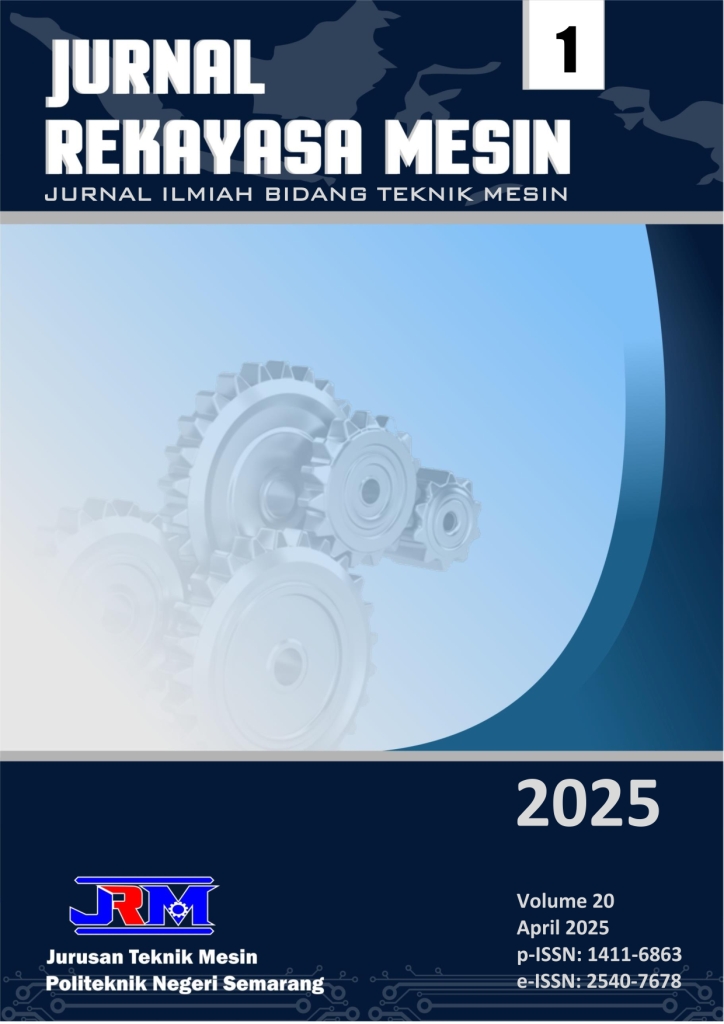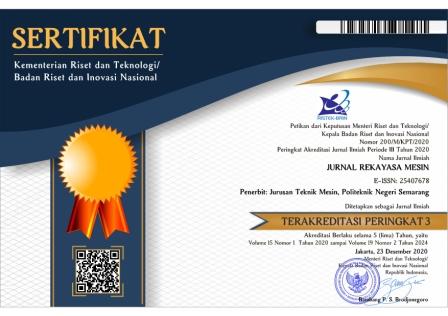Penerapan Siklus Plan-Do-Check-Action untuk Mengurangi Cacat Permukaan pada Produk Outer Tube Model 2DP di PT. XYZ
DOI:
https://doi.org/10.32497/jrm.v20i1.6211Keywords:
8 langkah TPS, Cacat permukaan, Diagram Pareto, Lean manufacturing, Outer tube, PDCAAbstract
Tingkat cacat permukaan pada outer tube model 2DP di area pemesinan PT.XYZ masih mencapai 3,91%, melebihi Key Performance Indicator (KPI) perusahaan sebesar 1,36%. Kajian terdahulu membuktikan efektivitas siklus Plan-Do-Check-Action (PDCA) di berbagai sektor, namun belum ada penelitian empiris yang memfokuskan penurunan cacat permukaan komponen otomotif pada proses pemesinan di Indonesia dan mengukur dampak langsung integrasi PDCA terhadap pencapaian KPI serta penghematan biaya perbaikan. Oleh karena itu, penelitian ini bertujuan untuk menurunkan cacat permukaan outer tube model 2DP mencapai KPI sebesar 1,36% dan menghemat biaya pengerjaan ulang. Metode yang digunakan dengan mengkombinasikan 8 Langkah Toyota Production System (TPS), diagram Pareto, dan diagram ishikawa untuk mengidentifikasi akar penyebab dan menetapkan prioritas perbaikan. Dengan melakukan perbaikan meliputi, pemotongan dua-tahap (roughing-finishing), modifikasi program turning, penggantian diameter tool rib, dan penggunaan jig semi-cavity, hasil penelitian menunjukkan penurunan tingkat cacat permukaan pada produk outer tube model 2DP dari 3,91% menjadi 1,32% serta memberikan penghematan biaya tahunan perusahaan hingga Rp. 600.780.000. Kesimpulannya, integritas siklus PDCA menggunakan 8 langkah TPS dan alat bantu kualitas efektif dalam meningkatkan kualitas produk dan efisiensi biaya di industri Otomotif. Penelitian ini memperluas bukti empiris lean manufacturing di industri otomotif di Indonesia, menyediakan kerangka praktis perbaikan berbiaya rendah namun berdampak tinggi serta integrasi dengan teknologi industri 4.0.
References
[1] Realyvasquez-Vargas, A., Arredondo-Soto, K.C., Carrillo-Gutierrez, T., Ravelo, G. Applying the Plan-Do-Check-Act (PDCA) cycle to reduce the defects in the manufacturing industry: a case study. Applied Science. 2018;8(11):2181.
[2] Gil-Vilda, F., Yagüe-Fabra, J.A., Sunyer, A. From lean production to lean 4.0: a systematic literature review with a historical perspective. Appl Sci. 2021;11(21):10131.
[3] García-Alcaraz, J.L., Sánchez Ramírez, C. Special issue on applied engineering to lean manufacturing production systems. Appl Sci. 2022;12(17):1–2.
[4] Simonsen, E.M., Herrera, R.F., Atencio, E. Benefits and difficulties of the implementation of lean construction in the public sector: a systematic review. Sustain. 2023;15(7):5852.
[5] Tasdemir, C., Gazo, R. A systematic literature review for better understanding of lean driven sustainability. Sustain. 2018;10(7):2564.
[6] Alefari, M., Almanei, M., Salonitis, K. Lean manufacturing, leadership and employees: the case of UAE SME manufacturing companies. Prod Manuf Res [Internet]. 2020;8(1):222–243.
[7] Henao, R., Sarache, W., Gómez, I. Lean manufacturing and sustainable performance: trends and future challenges. J Clean Prod. 2019;208:99–116.
[8] Abu, F., Gholami, H., Mat Saman, M.Z., Zakuan, N., Streimikiene, D. The implementation of lean manufacturing in the furniture industry: a review and analysis on the motives, barriers, challenges, and the applications. J Clean Prod. 2019;234(October):660–680.
[9] Botti, L., Mora, C., Regattieri, A. Integrating ergonomics and lean manufacturing principles in a hybrid assembly system: a case study. Comput Ind Eng. 2017;111:481-495.
[10] Gebeyehu, S.G., Abebe, M., Gochel, A. Production lead time improvement through lean manufacturing. Cogent Eng. 2022;9(1):2034255.
[11] Buer, S.V., Semini, M., Strandhagen J.O., Sgarbossa, F., Semini M., et al. The complementary effect of lean manufacturing and digitalisation on operational performance. 2021;59(6):1800-1818.
[12] Alefari, M., Almanei, M., Salonitis, K. Lean manufacturing, leadership and employees: the case of UAE SME manufacturing companies. Prod Manuf Res [Internet]. 2020;8(1):222–243.
[13] Rojas, T., Mula, J., Sanchis R. Quantitative modelling approaches for lean manufacturing under uncertainty. Int J Prod Res. 2024;62(16):5989–6015.
[14] Maware, C., Parsley D.M. The Challenges of lean transformation and implementation in the manufacturing sector. Sustain. 2022;14(10):1–24.
[15] Suhardi, B., Anisa, N., Laksono, P.W. Minimizing waste using lean manufacturing and ECRS principle in Indonesian furniture industry. Cogent Eng. 2019;6(1):1–13.
[16] Rossi, A.H.G., Marcondes, G.B., Pontes, J., Leitão, P., Treinta F.T., et al. Lean tools in the context of industry 4.0: literature review, implementation and trends. Sustain. 2022;14(19):1-32.
[17] Vanichchinchai, A. The effect of lean manufacturing on a supply chain relationship and performance. Sustainability. 2019;11:1-15.
[18] Saad Bajou, M., Chafi, A. Lean construction implementation in the moroccan construction industry: awareness, benefit and barriers. Journal of Engineering, Design and Technology. 2018;16(4):533-556.
[19] Maware, C., Adetunji, O. Lean manufacturing implementation in Zimbabwean industries : Impact on operational performance. 2019;11:1–12.
[20] Psarommatis, F., Prouvost, S., May, G., Kiritsis, D. Product quality improvement policies in Industry 4.0: characteristics, enabling factors, barriers, and evolution toward zero defect manufacturing. Front Comput Sci. 2020;2(August):1–15.
[21] Roshan, R., Guru, D., Paulssen, M. Customers’ experienced product quality : scale development and validation. European Journal Marketing. 2020;54(4):645–670.
[22] Olalere, I.O., Ramdass, K. Assessing the impact of quality improvement on production defectiveness: a case study on an automotive manufacturing industry. Cogent Eng. 2024;11(1):1-18.
[23] Iherobiem, A.C., Sanusi, A,O. Process innovation as a strategic tool in enhancing the performance of organizations: A study of manufacturing firms in Nigeria. Emerging Markets Journal. 2023;13(1):39-44.
[24] Zerbst, U., Madia, M., Klinger, C., Bettge, D., Murakami, Y. Defects as a root cause of fatigue failure of metallic components. I: Basic aspects. Eng Fail Anal. 2019;97(March):777–792.
[25] Zerbst, U., Madia, M., Klinger, C., Bettge, D., Murakami, Y. Defects as a root cause of fatigue failure of metallic components. II: Non-metallic inclusions. Eng Fail Anal. 2019;98(April):228–239.
[26] Zerbst U, Madia M, Klinger C, Bettge D, Murakami Y. Defects as a root cause of fatigue failure of metallic components. III: Cavities, dents, corrosion pits, scratches. Eng Fail Anal. 2019;97(January):759–776.
[27] Zerbst, U., Klinger, C. Material defects as cause for the fatigue failure of metallic components. Int J Fatigue. 2019;127(June):312–323.
[28] Ferro, P., Fabrizi, A., Berto, F., Savio, G., Meneghello, R., et al. Defects as a root cause of fatigue weakening of additively manufactured AlSi10Mg components. Theor Appl Fract Mech. 2020;108(March):102611.
[29] Vial, T., Dhouib, F., Roger, L., Blangero, A., Duvivier, F., et al. Dimensionality reduction to improve search time and memory footprint in content-retrieval tasks: Application to semiconductor inspection images. Adv. Ind. Manuf. Eng. 2022;5:100097.
[30] Goyal, A., Agrawal, R., Saha, C.R. Quality management for sustainable manufacturing: Moving from number to impact of defects. J. Clean. Prod. 2019;241:118348.
[31] Psarommatis, F., Sousa, J., Mendonça, J.P., Kiritsis, D. Zero-defect manufacturing the approach for higher manufacturing sustainability in the era of industry 4.0 : a position paper. 2022;60(1)-73-91.
[32] Sreedharan, V.R.; Rajasekar, S.; Kannan Santhosh, S.; Arunprasad, P.; Trehan, R. Defect reduction in an electrical parts manufacturer: a case study. TQM J. 2018;30:650–678.
[33] Dadashnejad, A.A., Valmohammadi, C. Investigating the effect of value stream mapping on operational losses: a case study. J. Eng. Des. Technol. 2018;16:478–500.
[34] Kohlmann, P., Sahling, F. A Flexible planning approach for integrated lot sizing and rework planning with random proportion of defective products. Int. J. Prod. Res. 2024;62(19):6961-6978.
[35] Psarommatis, F., May, G., Azamfirei, V. Zero defect manufacturing in 2024: a holistic literature review for bridging the gaps and forward outlook. Int. J. Prod. Res. 2024:1-37.
[36] Du, Y., Mukherjee, T., DebRoy, T. Physics-informed machine learning and mechanistic modeling of additive manufacturing to reduce defects. Appl. Mater. Today. 2021;24.
[37] Maware, C., Parsley, D.M. The effectiveness of teaching systematic problem-solving based on the revised bloom’s taxonomy in lean manufacturing training. 2024:289–304.
[38] Kholil, M., Hanum, B., Hendri, Almahdy, I. Finishing line evaluation of bracket product FWD RR spring BT 1702 by applying 8 Steps 7 tools method toyota production (Case study: PT BA). J. Phys. Conf. Ser. 2020;1529.
[39] Dudin, M.N., Smirnova, O.O., Vysotskaya, V., Frolova, E.E., Vilkova, N.G. The deming cycle (PDCA) concept as a tool for the transition to the innovative path of the continuous quality improvement in production processes of the agro-industrial sector. European Research Study Journal. 2017;XX(2B), 283–293.
[40] Jagusiak-kocik, M. PDCA cycle as a part of continuous improvement in the production company - a case study. Pord. Eng. Arch. 2017;14(14):19–22.
[41] Peças, P., Gamb, M., Sampayo, M., Jorge, D. Applied sciences PDCA 4.0 : a new conceptual approach for continuous improvement in the Industry 4.0 Paradigm. Applied Sciences. 2021;11(6):1-29.
[42] Kumar, R. Kaizen a tool for continuous quality improvement in Indian manufacturing organization. International Journal of Mathematical, Engineering and Management Sciences. 2021;4(02):452-459.
[43] Regent, T.M., Klunko, N.S., Egorova, L. V., Chernova, V. V., Meshkova, L., et al. Implementation of the continuous improvement cycle for business processes into the quality management system of pharmaceutical industry enterprises. Kurdish Studies. 2024;12(2):3917–3927.
[44] Maruta, R. The creation and management of organizational knowledge. Knowledge-Based Syst. 2014;67:26–34.
[45] Asif, M., De Vries, H.J., Ahmad, N. Knowledge creation through quality management. Total Qual. Manag. Bus. Excell. 2013;24:664–677.
[46] Seo, Y., Lee, C., Moon, H. An organisational learning perspective of knowledge creation and the activities of the quality circle. Total Qual. Manag. Bus. Excell. 2016;27:432–446.
[47] Purvis, B. Three pillars of sustainability : in search of conceptual origins. Sustain. Sci. 2019;14:681-695.
[48] Markulik, Š., Šolc, M., Fil’o, M. Applied sciences implementation of quality tools in mechanical engineering piece production. Applied Sciences. 2024;14(2):1-19.
[49] Lin, C.C., Chueh, J.W., Chen, H.M., Chiu, Y.H., Chu, D. Applying the toyota production system to decrease the time required to transport patients undergoing surgery from the general ward to the operating room and reviewing the essence of lean thinking. Front. Med. 2022;9:1–16.
[50] Wicaksono, P.A., Rozaq, R. Applying kaizen in quality for reducing dent defect per unit. IOP Conf. Ser. Mater. Sci. Eng. 2020;722.
[51] Junior, A.A., Broday, E.E. Adopting PDCA to loss reduction: a case study in a food industry in Southern Brazil. International Journal for Quality Research. 2013;13(2):335–348.
[52] Silva, A.S., Medeiros, C.F., Vieira, R.K. Cleaner production and PDCA cycle: Practical application for reducing the cans loss index in a beverage company. Journal of Cleaner Production. 2017:1-43.
[53] Kholif, A.M., Abou, D.S., Hassan, E., Khorshid, M.A., Elsherpieny, E.A., et al. Implementation of model for improvement (PDCA-Cycle) in dairy laboratories. J. Food Saf. 2018;e12451:1–6.
[54] Huang, Y., Huang, Y., Yi, L., Pan, W., Chen, Y. A FOCUS-PDCA quality improvement model for reducing the distribution defect rate of sterile packages. Sci. Rep. 2023;13(1):1–10.
[55] Nguyen, V., Nguyen, N., Schumacher, B. Practical application of Plan–Do–Check–Act cycle for quality improvement of sustainable packaging. Applied Sciences. 2020;10(6332):1-15.
[56] Arredondo-Soto, K.C., Blanco-Fernandez, J., Miranda-Ackerman, M.A., Solis-Quinteros, M.M., Realyvasquez-Vargas, A., et al. A Plan-Do-Check-Act based process improvement intervention for quality Improvement. IEEE Access. 2021;9:132779–132790.
[57] Amaral, V.P., Ferreira, A.C., Ramos, B. Internal logistics process improvement using PDCA : a case study in the automotive sector. Business System Research. 2022;13(3):100–115.
[58] Rangel-Sanchez, M.A., Urbona-Gonzalez, J.D.J., et al. Reduction of scrap in electric motor manufacturing for the automotive industry : a case study using PDCA approach. 2024.
[59] Li, C., Li, X., Wu, Y., Zhang, F., Huang, H. Deformation mechanism and force modelling of the grinding of YAG single crystals. Int. J. Mach. Tools Manuf. 2019;143(August):23–37.
[60] Gavalda Diaz, O., Garcia Luna, G., Liao, Z., Axinte, D. The new challenges of machining ceramic matrix composites (CMCs): review of surface integrity. Int. J. Mach. Tools Manuf. 2019;139:24–36.
[61] Liao, Z., Abdelhafeez, A., Li, H., Yang, Y., Diaz, O.G., et al. State-of-the-art of surface integrity in machining of metal matrix composites. Int. J. Mach. Tools Manuf. 2019;143(August):63–91.
[62] Zhan, S., Zhao, Y. Plasma-assisted electrochemical machining of microtools and microstructures. Int. J. Mach. Tools Manuf. 2020;156:103596.
[63] Han, W., Fang, F. Fundamental aspects and recent developments in electropolishing. Int. J. Mach. Tools Manuf. 2019;139:1–23.
[64] Liu, Y.Z. Coaxial waterjet-assisted laser drilling of film cooling holes in turbine blades. Int. J. Mach. Tools Manuf. 2020;150:103510.
[65] Marksberry, P., Badurdeen, F., Gregory, B., Kreafle, K. Management directed kaizen: Toyota’s jishuken process for management development. J. Manuf. Technol. Manag. 2010;21:670–686.
[66] Marksberry, P., Bustle, J., Clevinger, J. Problem solving for managers: a mathematical investigation of toyota’s 8-step process. J. Manuf. Technol. Manag. 2011;22:837–852.
[67] Fensel, D., Motta, E. Of Problem Solving Methods. IEEE Transactions on Knowledge and Data Engineering. 2001;13(6):913–932.
[68] Tinning, R. Teacher education pedagogy: dominant discourses and the process of problem setting. J. Teach. Phys. Educ. 2016;11:1–20.
[69] Yihua, M., Tuo, X. Research of 4M1E’s effect on engineering quality based on structural equation model. Syst. Eng. Procedia. 2011;1:213–220.
[70] Zhao, F., Wu, J., Zhao, Y., Ji, X., Zhou, L., et al. A machine learning methodology for reliability evaluation of complex chemical production systems. RSC Adv. 2020;10:20374–20384.
[71] Kaganski, S., Majak, J., Karjust, K. Fuzzy AHP as a tool for prioritization of key performance indicators. Procedia CIRP. 2018;72:1227–1232.
[72] Gözaçan, N., Lafci, Ç. Evaluation of key performance indicators of logistics firms. Logist. Sustain. Transp. 2020;11:24–32.
[73] Shahin, A., Mahbod, M.A. Prioritization of key performance indicators: an Integration of analytical hierarchy process and goal setting. Int. J. Product. Perform. Manag. 2007;56:226–240.
[74] Mahto, D., Kumar, A. Application of root cause analysis in improvement of product quality and productivity. J. Ind. Eng. Manag. 2008;1:16–53.
[75] Sawargaonkar, G.L., Davala, M.S., Rakesh, S., Kamdi, P.J., et al. Envirotyping helps in better understanding the root cause of success and limitations of rainfed production systems. Front. Environ. Sci. 2024; 12.
[76] Papageorgiou, K., Theodosiou, T., Rapti, A., Papageorgiou, E.I., et al. A systematic review on machine learning methods for root cause analysis towards zero-defect manufacturing. Front. Manuf. Technol. 2022;2:1–16.
[77] Vo, B., Kongar, E., Suarez-Barraza, M. Root-cause problem solving in an industry 4.0 context. IEEE Engineering Management Review. 2020;48(1):48–56.
[78] Shah, R., Ward, P.T. Defining and developing measures of lean production. Journal of Operations Management. 2007;25(4):785–805.
[79] Allio, M.K. A short, practical guide to implementing strategy. Journal of Business Strategy. 2005;26(4):12-21.
[80] Perrini, F., Tencati, A. Sustainability and stakeholder management: the need for new corporate performance evaluation and reporting systems. Bus. Strateg. Environ. 2006;15:296–308.
[81] Wheeler, D., Sillanpää, M. Including the stakeholders: the business case. Long Range Plann. 1998;31:201–210.
[82] Mor, R.S., Bhardwaj, A., Singh, S., Sachdeva, A. Productivity gains through standardization-of-work in a manufacturing company. J. Manuf. Technol. Manag. 2019;30:899–919.
[83] Nissinboim, N., Naveh, E. Process standardization and error reduction: a revisit from a choice approach. Saf. Sci. 2018;103:43–50.
[84] Realyvasquez-Vargas, A., Arredondo-Soto, K.C., Garcia-Alcaraz, J.L., Macias, E.J. Improving a manufacturing process using the 8Ds method. A case study in manufacturing company. Applied Sciences. 2020;10(2433):1-26.
[85] Velasquez Villagran, N., Estevez, E., Pesado, P., De Juanes Marquez, J. Standardization: a key factor of industry 4.0. 6th Int. Conf. eDemocracy eGovernment, ICEDEG. 2019:350–354.
[86] Zargari, A., Cantrell, P.A., Grise, W., et al. Application of statistical process control (SPC) software in total quality improvement (TQI). Proceedings: Electrical Insulation Conference and Electrical Manufacturing and Coil Winding Conference. 2002:829–834.
[87] Shari, H.A., Khalid, N., Ashaari, N.S., Judi, H.M. Statistical process control in plastic packaging manufacturing : a case study. Proceeding of International Conference on Electrical Engineering and Informatics. 2009:199–203.
[88] Syazwan Ab Talib, M., Abdul Hamid, A.B., Chin, T.A. Critical success factors of supply chain management : a literature survey and pareto analysis. EuroMed Journal of Business. 2015;10(2):234-263.
[89] Talib, F., Rahman, Z., Qureshi, M.N. Pareto analysis of total quality management factors critical to success for service industries. International Journal for Quality Research. 2010;4(2):155-168.
[90] Coccia, M. The fishbone diagram to identify, systematize and analyze the sources of general purpose technologies. Journal of Social and Administrative Sciences. 2018;4(4):291-303.
[91] Shinde, D.D., Ahirrao, S., Prasad, R. Fishbone diagram : application to identify the root causes of student – staff problems in technical. Wirel. Pers. Commun. 2018;100:653–664.
[92] Suárez-barraza, M.F., Rodríguez-gonzález, F.G., Suárez-barraza, M.F. Cornerstone root causes through the analysis of the Ishikawa diagram, is it possible to find them? a first research approach. International Journal of Quality and Service Sciences. 2018;11(2):302-316.
Downloads
Published
How to Cite
Issue
Section
License
Copyright (c) 2025 Jurnal Rekayasa Mesin

This work is licensed under a Creative Commons Attribution-NonCommercial-ShareAlike 4.0 International License.
Copyright of articles that appear in Jurnal Rekayasa Mesin belongs exclusively to Penerbit Jurusan Teknik Mesin Politeknik Negeri Semarang. This copyright covers the rights to reproduce the article, including reprints, electronic reproductions, or any other reproductions of similar nature.







